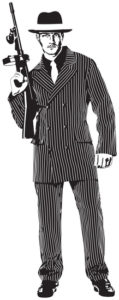Can a gun control law keep some weapons out of the hands of criminals? The concept of a gun control “law” sounds pointless, because criminals, being criminals, ignore laws. But the history of the machine gun in the US is an example of gun control that worked: When machine guns were outlawed, outlaws stopped using machine guns.
A machine gun is an “automatic” weapon, which means it fires multiple bullets when the trigger is pulled, and keeps firing until the trigger is released (unlike a “semi-automatic” weapon, which fires only one bullet with each pull of the trigger). That “spray” of bullets makes a machine gun a highly lethal weapon. In the 1920s and 1930s, law enforcement officers faced machine-gun wielding gangsters such  as Bonnie and Clyde, Pretty Boy Floyd and Machine Gun Kelly. In the 1929 infamous St. Valentine’s Day Massacre, Al Capone’s men mowed down seven members of Bugs Moran’s rival gang using machine guns. In the 1933 Kansas City Massacre, four police officers were killed by gangsters with machine guns. Machine guns were often the weapons of choice in deadly bank robberies. The 1930s Hollywood image of a gangster firing a Tommy-gun is based on reality.
as Bonnie and Clyde, Pretty Boy Floyd and Machine Gun Kelly. In the 1929 infamous St. Valentine’s Day Massacre, Al Capone’s men mowed down seven members of Bugs Moran’s rival gang using machine guns. In the 1933 Kansas City Massacre, four police officers were killed by gangsters with machine guns. Machine guns were often the weapons of choice in deadly bank robberies. The 1930s Hollywood image of a gangster firing a Tommy-gun is based on reality.
But then machine guns virtually disappeared. Why is that? What made the bad guys quit using such a powerful weapon?
Because of a gun-control law: the 1934 National Firearms Act. The law placed a $200 tax on the transfer of machine guns (and other weapons, such as short-barrel firearms) and required machine gun owners to register with the US Treasury. It was a tax, not a ban. But $200 was steep in 1934 – the equivalent of $3,658 in 2017 dollars.
When machine guns became more expensive and tougher to get, criminals stopped using machine guns. In the years since the law was passed, crimes with machine guns, owned legally or illegally, have been extremely rare.
It is impossible to know how many lives have been saved by the 1934 law. But think of recent mass murderers. None of them used machine guns, despite their obvious goal of killing as many people as possible. If James Holmes had opened fire in the Aurora, Colorado, movie theater with a machine gun instead of a semi-automatic rifle, how many more would have died? If the killer at Sandy Hook Elementary School had used a machine gun, how many more 6- and 7-year old children would he have killed? Picture Omar Mateen in 2016 walking into Pulse nightclub in Orlando, Florida, with a machine gun instead of a semi-automatic rifle. These were horrific attacks, among the bloodiest in US history. Imagine how much worse the carnage would have been if those killers had used automatic weapons.
The 1934 National Firearms Act is an example of gun control that worked. It made machine guns difficult to buy, and expensive. A recent Google search of “machine guns for sale” led to several websites, where prices were in the tens of thousands of dollars. Semi-automatic rifles are available for a few hundred dollars.
A mass murderer would naturally prefer the killing power of a machine gun. But because of the 1934 National Firearms Act, he will have to settle for less lethal weaponry. Which saves lives.